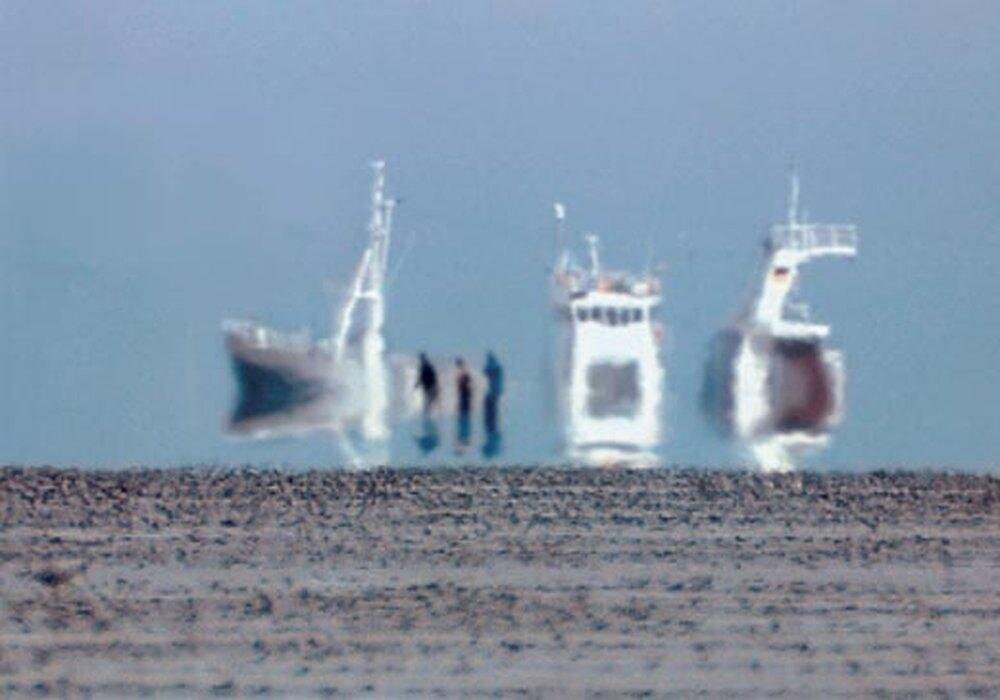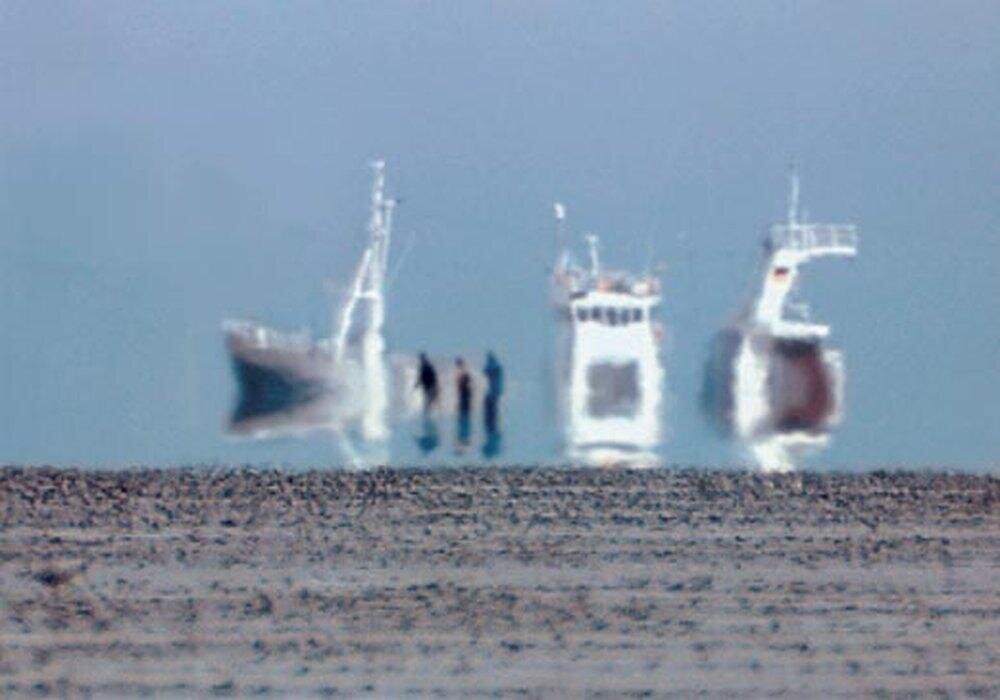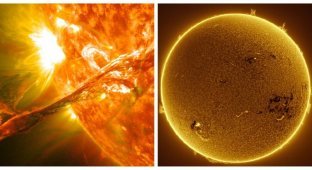How a mirage works, and what is “Fata Morgana” - the best friend of all conspiracy theorists (20 photos)
What comes to your mind when you hear the word "mirage"? I agree that there are few options here, although some music lovers of the late 80s and early 90s will probably remember a pop group with that name. 
Basically, mirages are usually understood as a kind of optical illusion, an illusion, if you will, a picture that does not exist in reality, created by the brain in response to certain conditions. 
Mirage
The most common mirage (motorists won’t let you lie) is a puddle of water that appears in very hot weather on a hot asphalt road. As the car approaches, the puddle gradually fades, and, after a moment, disappears altogether, since the water seen by the driver in the distance is nothing more than a reflection of the sky on the asphalt. 
Mirage on the road
More vivid and picturesque examples of mirages are often shown in feature films, when travelers wandering through the desert, exhausted by heat and thirst, see oases with cool water and shady palm trees. However, in this case we are not talking about a mirage, but about an illusion, when a person, under the influence of certain circumstances (in this case, climatic) gives what he wants as reality. The brain deceives it, and the receptors, in turn, begin to incorrectly perceive what they see. 
Mirage of an oasis in the desert
A mirage, unlike vision, is a real optical atmospheric phenomenon that occurs during the refraction of a stream of light at the boundary between layers of air of different temperatures. In simple terms, when a ray of light changes its direction and moves from an air layer of one temperature to a layer of another temperature, a mirage occurs. And, by the way, a mirage is not an illusion, since an illusion, as we found out above, is a deception created by the human brain, and a mirage is a really occurring effect, and there is no deception at all. 
How a mirage is formed
In fact, mirages appear every day in different parts of the world. True, it is not always that a person witnesses this unique phenomenon. And studying them is not easy, since mirages do not appear on order and it is in principle impossible to predict their appearance, but scientists are trying. Moreover, the first mention of mirages is given in Aristotle’s treatise “Meteorology”, where the author talks about the inhabitants of the Hellenic colony on the eastern coast of Sicily, who for several hours could observe the coast of continental Italy, although it was 150 km away... 
Aristotle's Meteorology
A scientific explanation for this optical phenomenon appeared only in 1799. French physicist Gaspard Monge, after his expedition through the Egyptian desert, said that a similar effect occurs due to the refraction and reflection of light. 
Gaspard Monge
Well, the study of such a natural phenomenon as a mirage began almost simultaneously with the appearance of ship logs on ships, in which, in fact, absolutely all the phenomena that happened to the ship during the voyage were recorded. So, for example, the ancient book “Daily Notes on the Voyage to the Northern Whale Fishing, Containing Research and Findings on the East Coast of Greenland” tells about a large city that was seen by the commander of the ship “Baffin” in the summer of 1820. The captain was so impressed by the splendor of this unknown city that he hastened to sketch at least the general features in order to return in the future and get to know the city better. Of course, no other navigator was able to find it... 
Mirage at sea
And these, of course, are not isolated cases. So, in 1840, residents of a small island north of England saw beautiful white buildings in the sky and decided that this was confirmation of the existence of the fabulous Finn people, who lived in the sky in a crystal city. And in 1889, a large city with skyscrapers, high towers and spiers, temples,similar to mosques, which, of course, did not exist and could not exist in Kamchatka. 
Mount Fairweather
Currently, scientists know everything and nothing at the same time about mirages, and yes, this could very well happen. Mirages occur where several layers of air of different temperatures meet. Warm air is thinner than cold air, and light travels faster in it. In physics, this difference is determined by the refractive index: warm air has a lower refractive index, and cold air has a higher one. So, a mirage occurs at the moment when light, bending its path, seems to be reflected from unevenly heated layers of air of different densities. 
The traveler sees the sky in two places at once: above, as usual, and near the ground, in front of the palm tree. This creates in his eyes a picture of an oasis with a cool pond. But there is no water anywhere, and the blue lake is a mirage
For example, rays from a bright sky, moving towards the earth, are reflected and at a certain angle fall into a person’s field of vision, and the person, in turn, sees a reflection of the sky on the earth, which very much reminds him of water. And a completely opposite situation occurs when the air below is cold and the air above is hot. In this case, the so-called reverse curvature occurs, and the person sees objects higher than they are actually located. In general, very interesting, but nothing is clear! 
Mirage
Today, scientists studying this atmospheric phenomenon identify several main types of mirages, differing from each other in temperature and direction of reflection of light rays: lower, upper, side mirages and Fata Morgana. The inferior mirage is considered the most common - this is exactly the same ill-fated puddle of water that drivers see on the asphalt on a hot day. 
Inferior Mirage
An inferior mirage occurs when warmer air is located below and cooler air is located above. The superior mirage occurs much less frequently, and for it to occur it is necessary for the cold air to “lie” lower than the warm air. When an upper mirage occurs, a person can, in principle, imagine whatever his heart desires, and he remains in the field of vision much longer. 
Superior Mirage
The principle of the occurrence of a side mirage is somewhat similar to the principle of the occurrence of a lower one, only in this case the warm air is located on the side. For example, a heated wall can act as a heat source, in the reflection of which a person, as if in a mirror, is able to see the objects surrounding it. 
Side mirage. The gray uneven wall of the fortress in the side mirage became as if polished, transparent
And somewhat different from the above types of mirages is Fata Morgana, whose name is more suitable for a fairy-tale witch or villainess from one of the famous comic book cinematic universes. And all because to this day no intelligible and convincing scientific explanation has been found for this phenomenon. 
Mirage "Fata Morgana"
“Fata Morgana,” according to scientists, is considered the most complex and mysterious type of mirages, which is why the name was chosen accordingly - in honor of the heroine of the Breton epic Fata Morgana, the half-sister of King Arthur. At one time, the girl was rejected by Lancelot, and in upset feelings settled at the bottom of the sea in a crystal palace, and in order not to be too boring, she took up a hobby - to tease and lead sailors astray with ghostly visions. 
Mirage "Fata Morgana"
Fata Morgana is considered a complex, multi-layered mirage, the appearance of which occurs as a result of alternating layers of warm and cold air. The result of such multi-layering is often amazing optical effects: for example, the multiplication of images, when instead of one object a person sees several repeating ones, and they can be inverted, enlarged or reduced. 
Mirage "Fata Morgana"
“But this simply cannot be!” - you exclaim. And hereand maybe... Moreover, the existence of the Fata Morgana mirage is confirmed by facts. So, for example, on April 3, 1900, the Boers, the defenders of Bloemfontein, witnessed the appearance of the British army's battle formations in the sky. This phenomenon was so clear that they could even see the buttons on the red uniforms of the officers! At that moment, the mirage was perceived as a bad omen, and two days later the capital of the Orange Republic fell. 
Boers with captured Lee-Metford rifles in their hands
Another example. On December 10, 1941, the crew of the British transport Vendor, located in the Maldives, noticed a burning ship on the horizon. “Vendor” hurried to help the ship in distress, but did not have time - the ship sank. However, Vendor approached the supposed site of the ship's death to try to find possible survivors, but found absolutely nothing. 
Vessel "Vangard" (similar to "Vendor")
There were basically no signs of the tragedy that had just occurred at the site. The “Vendor” headed to the destination port, and already there it turned out that at the same time when the crew of the ship observed the “fictitious” tragedy, 900 km from this place, the cruiser “Repulse” was actually in distress, attacked by Japanese torpedo bombers. This is such an evil irony...or rather, a mirage. 
Cruiser "Repulse" during a cruise






























